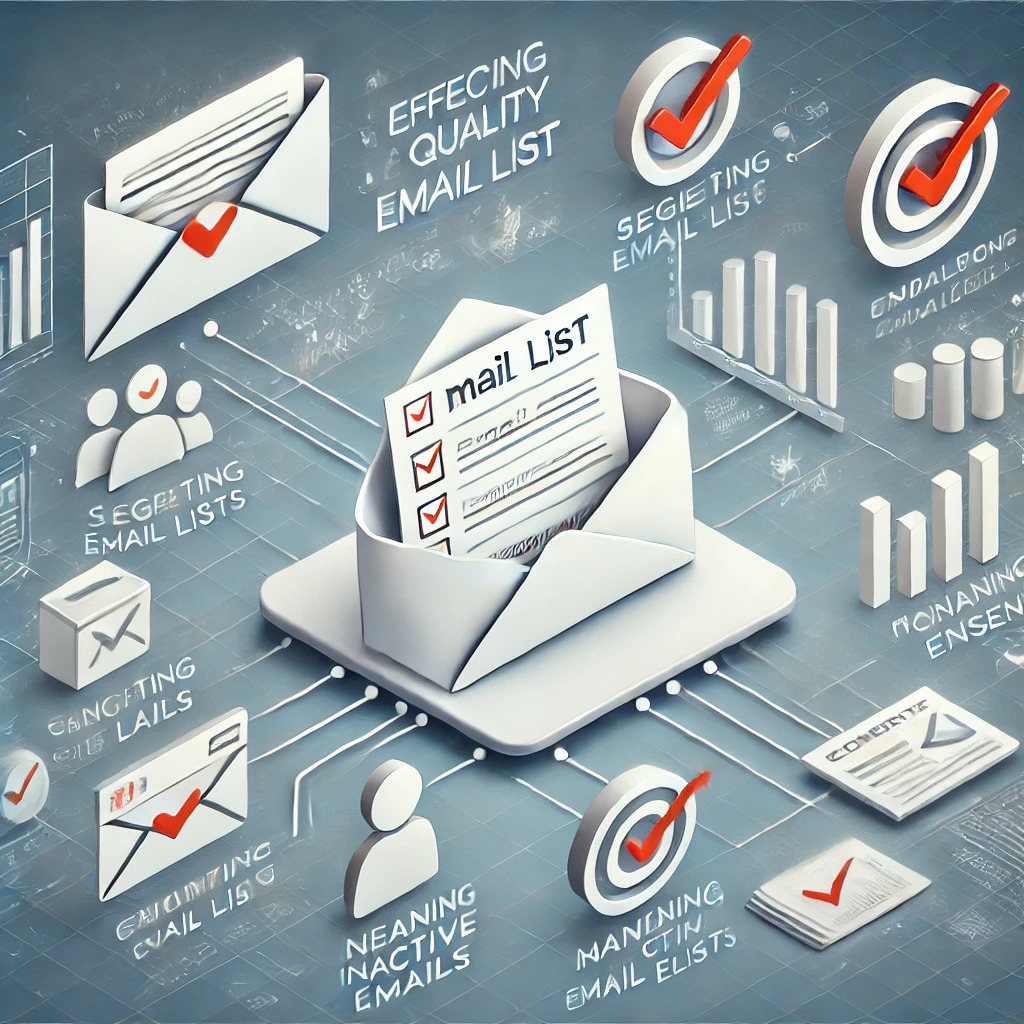Effective email list management is essential for running successful email marketing campaigns. Building and maintaining a healthy, engaged email list ensures that your messages reach the right audience and result in meaningful interactions. However, managing an email list is not just about collecting addresses—it’s about nurturing and maintaining that list with care and strategy. In this article, we will explore three key aspects of email list management: best practices for building a quality list, the importance of maintaining list hygiene, and common mistakes to avoid. By following these guidelines, you can improve deliverability, boost engagement, and achieve better overall performance in your email marketing efforts.
A quality email list is the foundation of any successful email marketing campaign. Effective Email List Management ensures your emails engage your audience and drive conversions. To build and grow an effective email list, focus on ethical practices, obtaining consent, and segmenting your subscribers for targeted campaigns. Here are the best practices for building and growing a quality email list.
Importance of Obtaining Consent Before Adding Subscribers
One of the most important principles in Email List Management is obtaining explicit consent before adding someone to your email list. This ensures that your subscribers are genuinely interested in receiving your content, which helps you avoid potential legal issues and builds trust with your audience. Under regulations like GDPR (General Data Protection Regulation) and CAN-SPAM, sending unsolicited emails is not only ineffective but can also result in penalties.
Obtaining consent can be done through clear, visible opt-in forms on your website, landing pages, or social media. A simple checkbox that allows users to agree to receiving emails, accompanied by an explanation of what kind of content they will receive, is an effective way to obtain consent. This transparent approach is a cornerstone of ethical Email List Management, ensuring a trustworthy relationship with subscribers.
Techniques for Collecting Emails Ethically
Once you’ve emphasized consent, the next step is using ethical and effective techniques to collect email addresses. Effective Email List Management begins with opt-in forms placed prominently on your website, such as on your homepage, blog posts, or exit intent pop-ups. These forms allow visitors to subscribe to your list easily. Ensure that the opt-in form is simple and doesn’t require unnecessary information, aligning with good Email List Management practices.
Another powerful tool for collecting email addresses is offering lead magnets. Lead magnets, such as free eBooks, discount codes, webinars, or exclusive content, incentivize potential subscribers to provide their email. Not only does this help build your list, but it also demonstrates effective Email List Management by ensuring subscribers are genuinely interested in what you offer.
How to Segment Your Email List for Targeted Marketing
Once you’ve built a robust email list, Email List Management becomes critical for maintaining relevance. Segmenting your list means dividing subscribers into smaller, targeted groups based on demographics, purchase history, engagement, or behavior. Proper segmentation, a key aspect of Email List Management, allows you to send the right message to the right people at the right time.
For instance, if you run an e-commerce store, you can segment your list by purchase history, sending personalized offers to customers based on previous purchases. You can also segment by geographical location to send region-specific updates. The effectiveness of segmentation lies in data tracking, which supports better Email List Management and enhances the relevance of your emails.
In conclusion, Building and growing a quality email list hinges on strong Email List Management practices. By obtaining consent, collecting emails ethically, and segmenting your list effectively, you can maintain a highly engaged audience. Effective Email List Management ensures your email marketing campaigns lead to better engagement, higher conversions, and an improved ROI.
Maintaining Email List Hygiene: The Key to Better Deliverability

Maintaining email list hygiene is crucial for the success of your email marketing campaigns. A clean and well-maintained email list ensures better deliverability, improved engagement rates, and reduces the risk of getting marked as spam. Regularly cleaning your list and respecting user preferences can significantly enhance the performance of your campaigns. Below are key practices for maintaining email list hygiene and improving your email deliverability.
How to Clean Your Email List Regularly to Remove Inactive or Invalid Addresses
One of the most important aspects of email list hygiene is regularly cleaning your email list to remove inactive or invalid addresses. Inactive subscribers are those who haven’t opened or interacted with your emails for a long time. Continuing to send emails to these users can harm your sender reputation and lower your deliverability rate, as email service providers (ESPs) might flag your emails as spam.
To clean your list, use email marketing tools that help you identify and segment inactive subscribers. For instance, you can create a segment of subscribers who haven’t engaged with your emails in the past six months or year. You can then either re-engage these subscribers with a targeted campaign or remove them from your list if they don’t respond. Removing invalid email addresses—such as those that result in hard bounces—also ensures that your emails are reaching legitimate users. Additionally, removing any misspelled email addresses or those flagged as undeliverable helps maintain the health of your list and improves email deliverability.
The Role of Unsubscribe Links and Respecting User Preferences
An essential component of maintaining email list hygiene is respecting your subscribers’ preferences, especially when it comes to opting out. Including a clear and visible unsubscribe link in every email is not only a legal requirement in many countries (e.g., CAN-SPAM Act) but also an important aspect of maintaining a healthy list. Making it easy for users to unsubscribe ensures that those who no longer wish to receive your emails can easily opt out, rather than marking your emails as spam.
Moreover, respecting user preferences means offering them the ability to update their subscription settings. Some users may want to receive fewer emails or prefer content related to specific topics. By allowing subscribers to manage their preferences, you can avoid frustrating them with irrelevant emails and maintain a more engaged and interested audience. This practice also helps you segment your list more effectively, sending more targeted emails to those who still wish to hear from you.
Best Practices for Handling Bounced Emails and Managing Spam Complaints
Handling bounced emails is another critical aspect of list hygiene. Soft bounces, which occur when an email can’t be delivered temporarily due to a full inbox or server issue, should be retried. However, hard bounces—which happen when an email address is invalid or no longer exists—should be removed from your list immediately to prevent damaging your sender reputation.
Managing spam complaints is equally important. If subscribers mark your emails as spam, it can significantly impact your deliverability. To reduce spam complaints, ensure that your emails are highly relevant, well-targeted, and provide clear opt-out options. Regularly monitoring feedback loops provided by ESPs allows you to identify and address issues before they escalate. You can also implement double opt-in to ensure that subscribers genuinely want to receive your emails, further reducing the risk of complaints.
In conclusion, maintaining email list hygiene is essential for keeping your email marketing efforts effective. Regularly cleaning your list, respecting user preferences with clear unsubscribe options, and managing bounces and spam complaints are key practices that improve your sender reputation and ensure better deliverability. By following these best practices, you can maintain a clean, engaged email list that will drive better results for your campaigns.
Effective email list management is crucial for building lasting relationships with your subscribers, but making common mistakes can undermine your efforts and harm your business’s reputation. Over-sending emails, sending generic messages, and misusing data can negatively impact engagement rates, increase unsubscribes, and even lead to legal issues. By understanding and avoiding these mistakes, you can build a more effective and ethical email marketing strategy.
Over-Sending and Spamming Your Email List: Why It’s Harmful
One of the most common mistakes in email list management is over-sending emails to subscribers. Bombarding your list with too many emails, especially unsolicited ones, can annoy your subscribers and lead to high unsubscribe rates or, worse, your emails being marked as spam. This not only reduces engagement but also harms your sender reputation, which could affect deliverability and email open rates.
To avoid spamming your list, it’s essential to strike the right balance. Keep your emails relevant and spaced out, and send them at optimal times. You can also offer subscribers the ability to choose the frequency of emails they receive. This way, you ensure that your emails are welcome and your subscribers remain engaged.
The Importance of Personalizing Emails and Avoiding Generic Messages
Another critical mistake in email list management is sending generic, one-size-fits-all emails. Generic emails can feel impersonal and fail to resonate with your audience. Personalization, on the other hand, can significantly boost engagement. Personalizing emails by including subscribers’ names, referencing their previous interactions with your brand, or tailoring content to their specific needs can create a more meaningful connection with your audience.
Personalization goes beyond using someone’s first name in the subject line. It involves segmenting your email list based on factors like demographics, purchase history, or engagement behavior. For example, if a customer previously purchased a product, you can send personalized emails with product recommendations, special offers, or tips related to their purchase. This level of relevance increases the chances of the recipient engaging with the content and taking action.
Misusing Data and Privacy Violations: Understanding Legal Compliance (e.g., GDPR, CAN-SPAM)
Another mistake that can have serious consequences is misusing subscriber data or violating privacy laws. With regulations like GDPR (General Data Protection Regulation) in Europe and CAN-SPAM in the United States, businesses must ensure they handle customer data responsibly. Violating these regulations can lead to hefty fines and damage your brand’s reputation.
To comply with these regulations, businesses should always obtain explicit consent from subscribers before adding them to email lists, and make it clear what kind of emails they will receive. Offering a transparent opt-in process and a clear privacy policy helps ensure that subscribers understand how their data will be used. Furthermore, you must provide an easy way for users to opt out of emails, and honor unsubscribe requests promptly.
In conclusion, avoiding common email list management mistakes—such as over-sending emails, sending generic content, and misusing data—can greatly improve the effectiveness of your email marketing campaigns. By respecting your subscribers’ preferences, personalizing content, and complying with data protection laws, you can build stronger relationships with your audience, improve engagement, and protect your brand’s reputation.
Conclusion
In conclusion, effective email list management is a critical component of successful email marketing. By following best practices for building and growing a quality email list, maintaining hygiene to ensure high deliverability, and avoiding common mistakes, businesses can significantly enhance their email marketing efforts. Proper consent, list cleaning, personalization, and legal compliance all play a role in creating an email strategy that not only reaches the right audience but also builds trust and fosters long-term customer relationships. By staying mindful of these key principles, you can improve engagement, reduce unsubscribes, and create a strong, reliable email list that supports your marketing goals.



